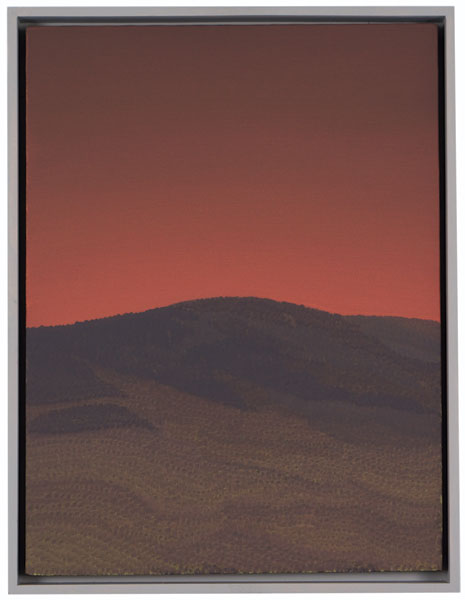
May 2015
Jake Longstreth: “Free Range” at Gregory Lind Gallery

"Particulate Matter 36", 2014
Oil on canvas, 17? x 13?
For several years, Jake Longstreth’s rigorously restrained paintings have been a study in man’s encroachment on nature, replete with big box shopping centers and monolithic strip mall signage indicative of suburban homogeneity. The recent works for his solo exhibition “Free Range” at Gregory Lind Gallery allow the viewer to locate themselves as partici- pants in the harsh, ex-urban world that he portrays. In his series collec- tively titled Los Angeles, the perfectly simulated murky skies are emblematic of LA atmosphere in the late summer. Seemingly serene, the foregrounds are accented with delicate pointallistic treetops and shrubs. But as the eyes sink into the skies that dominate most of the scene, an apocalyptic yellow ochre undertone is noticed lurking behind the sheer, pale blue and whites of the horizon. If familiar with Los Ange- les and its views from the Angeles Crest Highway, one knows that the city can be seen for miles on a clear day. Here, there is no city to see, just a thick blanket of signature smog trying to pawn itself off as a gorgeous vista.
Summertime in LA is fire season, which poses environmental prob- lems not only for LA residents, but also for the surrounding Angeles Forest, which goes ablaze every year without fail, igniting the hills into a fury. Fires generate abundant particulate matter, creating a thickness in the air that reflects the sun’s rays resulting in acrid tonal skies, such as portrayed in the piece aptly titled Particulate Matter 36. A muddy red haze covers the horizon above a dark knoll. A slight glow emanates from the behind the hill, alluding to hot embers burning behind it in the distance as the onlooker awaits the landscape’s fiery fate. Hanging next to it is Suppression 3, which seems to be the backside of the hill in Particulate Matter 36. In Suppression 3, five small fires have begun to kindle on a hill while choking black clouds billow up, covering half the sky. Though not a diptych, Longstreth wanted to emphasize a personal relationship between the two works that he hoped would also correlate with the viewer. As with all the work, the scenes in the paintings are imaginary and based upon personal reflection, but poignantly show the reality of man’s ability to spoil nature.
